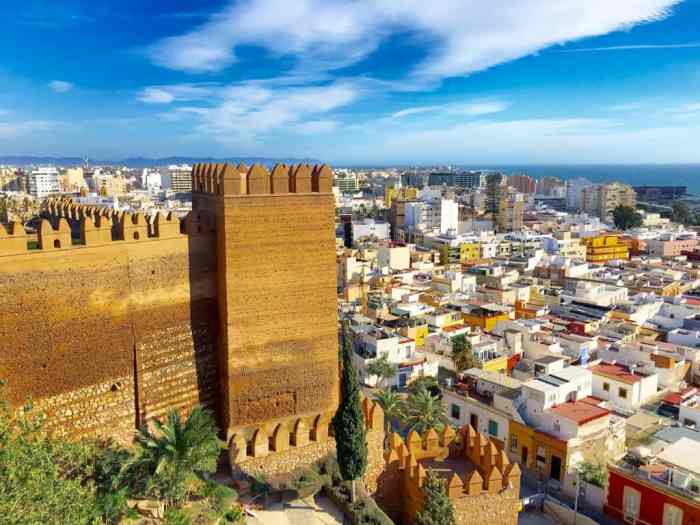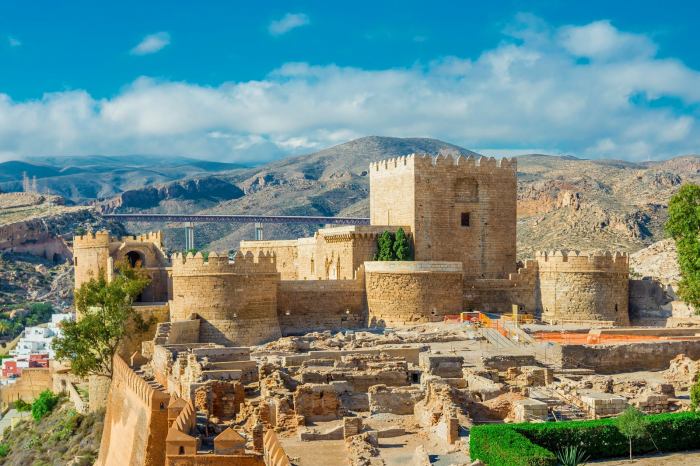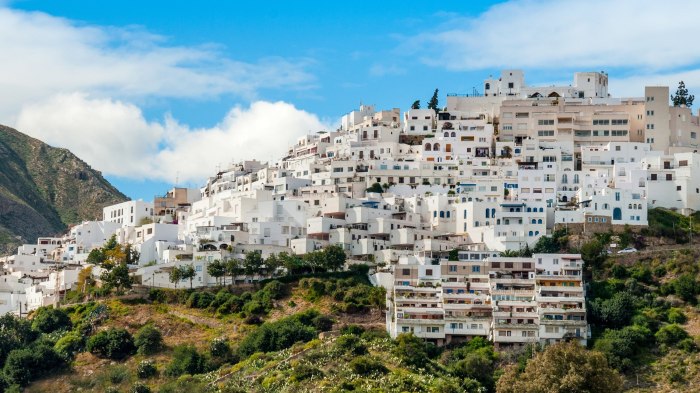Almeria, a captivating province nestled in the heart of Andalusia, beckons travelers with its rich tapestry of history, vibrant culture, and breathtaking natural landscapes. From its ancient origins to its modern-day allure, Almeria invites us on an enthralling journey that unveils the essence of this enchanting destination.
Almeria’s storied past unfolds like a captivating tale, with each era leaving an indelible mark on its cultural and architectural heritage. The province’s strategic location has shaped its destiny, as civilizations from the Phoenicians to the Romans, and the Moors to the Spanish, have left their imprint on its soil.
History of Almeria
Almeria’s rich history dates back to ancient times, with evidence of human settlements as early as the Bronze Age. Its strategic location on the Mediterranean coast has made it a coveted territory throughout history, influencing its development and leaving a legacy of diverse cultures.
The origins of Almeria can be traced to the Phoenician settlement of Urci in the 6th century BC. It later came under Roman rule, becoming part of the province of Hispania Tarraconensis. After the fall of the Roman Empire, Almeria was conquered by the Visigoths and later by the Moors in the 8th century AD.
Moorish Period
Under Moorish rule, Almeria flourished as a major port city and cultural center. The city was fortified with a massive fortress, the Alcazaba, and became a hub for trade and commerce. It was during this period that Almeria experienced its golden age, with the construction of magnificent mosques, palaces, and public baths.
Christian Reconquest
In the 13th century, Almeria was reconquered by the Christian forces of Castile. The city became part of the Kingdom of Granada and was ruled by the Nasrid dynasty. Under Christian rule, Almeria continued to be an important port and commercial center, but its significance gradually declined with the rise of other ports along the Mediterranean coast.
Modern Era
In the 19th century, Almeria experienced a period of economic growth and modernization. The city became a major center for mining and agriculture, and its population grew rapidly. During the Spanish Civil War, Almeria was a stronghold of the Republican forces and suffered heavy damage.
After the war, Almeria underwent a period of reconstruction and recovery. Today, it is a thriving city with a diverse economy and a rich cultural heritage.
Geography of Almeria

Almeria, a captivating province nestled in the southeastern corner of Andalusia, boasts a prime location on the Iberian Peninsula. Bordered by the Mediterranean Sea to the south and the Sierra Nevada mountains to the north, Almeria enjoys a strategic position, connecting it to other regions of Spain and beyond.
Almeria’s physical features are as diverse as its history. Its coastline, stretching over 217 kilometers, is dotted with pristine beaches, rugged cliffs, and charming fishing villages. The province’s mountainous terrain, dominated by the Sierra Nevada, provides breathtaking landscapes and offers opportunities for hiking, skiing, and other outdoor adventures.
Climate and Vegetation
Almeria’s climate is characterized by warm, dry summers and mild winters, with an average annual temperature of 18 degrees Celsius. The province receives minimal rainfall, making it one of the driest regions in Europe. This arid climate has given rise to a unique vegetation, dominated by drought-resistant plants such as the esparto grass and the prickly pear cactus.
Culture of Almeria

Almeria’s culture is a rich tapestry of traditions, customs, and festivals that have been shaped by its diverse history and geographic location. From the vibrant music and dance to the delectable culinary delights, Almeria offers a unique cultural experience.
Artistic Expressions
Almeria has a thriving arts scene, with a diverse range of artistic expressions. The region is renowned for its traditional music, which often features flamenco influences. Local dance forms include the lively sevillanas and the more somber fandangos.
Literature also plays an important role in Almeria’s culture. The region has produced several notable writers, including the poet Federico García Lorca and the novelist Juan Goytisolo.
Almeria, with its stunning beaches and rugged landscapes, offers an eco-conscious escape. Consider eco-friendly travel tips such as reducing your carbon footprint by opting for local transportation or staying in sustainable accommodations. Discover hidden coves, hike through pristine trails, and immerse yourself in the unspoiled beauty of Almeria while minimizing your environmental impact.
Culinary Delights
Almeria’s cuisine is a reflection of its coastal and agricultural heritage. Seafood dishes are particularly popular, with specialties including grilled sardines, fried anchovies, and calamares (squid rings). The region is also known for its stews, such as olla gitana (gypsy stew) and gurullos (pasta with rabbit and vegetables).
Nestled in Andalusia, Almería boasts a rich cultural heritage that manifests in its vibrant festivals. From the traditional Fiestas del Corpus Christi to the contemporary Almería International Film Festival, the city offers a diverse array of events that celebrate its history, art, and traditions.
For a glimpse into the world’s most captivating cultural festivals, explore best cultural festivals worldwide and discover the allure of Almería’s cultural tapestry.
Almeria’s desserts are equally tempting, with local specialties including piononos (sweet pastries filled with cream) and leche frita (fried milk). The region also produces a variety of wines, including the sweet dessert wine Pedro Ximénez.
Economy of Almeria

Almeria’s economy is primarily driven by agriculture, tourism, and related industries. The province is a major producer of agricultural products, including fruits, vegetables, and flowers. The tourism sector is also significant, with Almeria attracting visitors to its beaches, historical sites, and natural beauty.
Agriculture
Almeria is one of the leading agricultural producers in Spain, known for its greenhouse cultivation. The province’s mild climate and abundant sunshine make it ideal for growing a wide variety of fruits and vegetables, including tomatoes, peppers, cucumbers, and eggplants. These products are exported throughout Europe and beyond. In addition to greenhouse cultivation, Almeria also has a significant olive oil industry.
Tourism
Tourism is a major economic driver for Almeria. The province is home to a number of popular tourist destinations, including the beaches of Cabo de Gata, the historic city of Almeria, and the Sierra Nevada National Park. Almeria’s tourism infrastructure is well-developed, with a range of hotels, restaurants, and other amenities available to visitors.
Infrastructure and Transportation in Almeria

Almeria’s transportation network is well-developed, connecting the province to major cities in Spain and beyond. The province is served by a network of highways, including the A-7 motorway, which runs along the Mediterranean coast, and the A-92 motorway, which connects Almeria to Granada and Seville.
Almeria has a modern airport, Almeria Airport, which offers both domestic and international flights. The airport is located just 9 kilometers from the city center and is easily accessible by public transportation.
Public Transportation
Almeria has a comprehensive public transportation system that includes buses, trains, and a tram line. The bus network is extensive, with buses serving all major towns and villages in the province. The train network is also well-developed, with regular services to major cities in Spain, including Madrid, Barcelona, and Valencia. The tram line connects the city center to the beach resort of El Toyo.
Infrastructure
Almeria has a modern and reliable infrastructure. The province has a stable electricity supply, a clean and safe water supply, and a modern waste management system. Almeria is also home to several renewable energy projects, including solar and wind farms.
Tourism in Almeria

Almeria boasts a rich tapestry of attractions that captivates visitors from around the globe. From its captivating historical sites to its breathtaking natural wonders and vibrant cultural landmarks, Almeria offers a kaleidoscope of experiences for every traveler.
If you’re planning a beach holiday to Almería, you’ll need to pack all the essentials. Check out our beach holiday packing list for a comprehensive guide to everything you need to bring. From swimwear to sunscreen, we’ve got you covered.
And don’t forget your camera to capture all the stunning scenery that Almería has to offer!
Historical Sites, Almeria
- Alcazaba of Almeria: A formidable Moorish fortress dating back to the 10th century, offering panoramic views of the city and the Mediterranean Sea.
- Cathedral of Almeria: A stunning Renaissance-Gothic masterpiece with a striking facade and an elaborate interior.
- Cabo de Gata-Níjar Natural Park: A breathtaking coastal paradise with pristine beaches, rugged cliffs, and volcanic landscapes.
Natural Wonders
- Sierra Nevada National Park: The highest mountain range in mainland Spain, offering breathtaking scenery, hiking trails, and skiing opportunities.
- Desierto de Tabernas: A unique desert landscape known as the “European Hollywood” due to its frequent use as a filming location.
- Karst in Yesos de Sorbas: An extraordinary network of caves and sinkholes formed by the erosion of gypsum, creating surreal and awe-inspiring formations.
Cultural Landmarks
- Museo de Almeria: A fascinating museum showcasing the region’s rich history, from prehistoric times to the present day.
- Teatro Cervantes: A beautiful 19th-century theater that hosts a variety of performances, including plays, concerts, and dance shows.
- Alcazaba Festival: An annual summer festival featuring music, dance, and theatrical performances held within the walls of the Alcazaba.
Tourism Infrastructure
Almeria boasts a well-developed tourism infrastructure, with a wide range of hotels, restaurants, and tour operators catering to the needs of visitors. The city is well-connected by air, rail, and road, making it easily accessible from both within Spain and abroad.
Tourism Activities
Almeria offers a diverse array of tourism activities to suit every taste. Visitors can explore its historical sites, embark on adventure activities in its stunning natural surroundings, or simply relax and soak up the sun on its beautiful beaches.
Summary

As we bid farewell to Almeria, we carry with us a profound appreciation for its multifaceted charm. Its ancient ruins whisper tales of bygone eras, its vibrant culture captivates the senses, and its natural wonders inspire awe and tranquility. Almeria has etched an unforgettable mark on our hearts, leaving us with a longing to return and delve deeper into its enchanting embrace.
FAQ Corner
What is Almeria best known for?
Almeria is renowned for its rich history, stunning coastline, and unique cultural heritage, including its Moorish architecture and traditional festivals.
What are some must-see attractions in Almeria?
Almeria boasts numerous attractions, including the Alcazaba of Almeria, the Cabo de Gata-Níjar Natural Park, and the Cathedral of Almeria.
What is the best time to visit Almeria?
Almeria enjoys a Mediterranean climate with warm, sunny summers and mild winters. The best time to visit is during the shoulder seasons (April-May and September-October) for pleasant weather and fewer crowds.